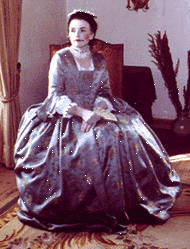
Women's Clothing in 18th-Century Louisbourg
 Women of the upper class circle of Louisbourg society wore a chemise, a pair of stays, sometimes completed with a stomacher, a petticoat, and a robe Ó la franšaise (French style dress). On their feet they wore coloured stockings made most often of silk and fine wool, with either leather or fabric high heel shoes. The headwear for these women was usually a coiffe of muslin or fine linen. The neckerchief would be a similar fine fabric as that of a coiffe and would be tied around the shoulders. When venturing into the cold weather of the Louisbourg winters they wore a long hooded cape or a mantelet along with a pair of mitons.
Women of the upper class circle of Louisbourg society wore a chemise, a pair of stays, sometimes completed with a stomacher, a petticoat, and a robe Ó la franšaise (French style dress). On their feet they wore coloured stockings made most often of silk and fine wool, with either leather or fabric high heel shoes. The headwear for these women was usually a coiffe of muslin or fine linen. The neckerchief would be a similar fine fabric as that of a coiffe and would be tied around the shoulders. When venturing into the cold weather of the Louisbourg winters they wore a long hooded cape or a mantelet along with a pair of mitons.
The stays were worn over the chemise. There were two distinct kinds of bodices: the corps and the corset. The corps had whalebone and was a type of stay. However the corset, which was made of silk, fine wool, cotton, or quilted linen was a comfortable garment that ladies wore when they disrobed. The stomacher was a triangular-shaped stay made of a firm material covered by fabric which matched that of the corset. This was placed beneath the laces of the corset.
The robe Ó la franšaise was a very popular style at this time. Even though the women of the higher classes wore these common style dresses, they were very distinguishable from those of the commoner. These dresses would have been made of more colourful, finer materials with elaborate designs. This made the difference in quality and price very easy to determine. The petticoat, usually made of fine linen or silk, was shorter than the dress and would have been worn underneath.
Mitons were similar to mittens except they had no finger or thumb holes. Made of either velvet or knitted black silk, they were used to keep the arms protected from the harsh cold of winter.
 A woman of the more common class wore a plain chemise of coarse linen under a pair of stays and a jacket. Made of wool or cotton. it was worn with a skirt of the same fabric. They also wore a bonnet, neckerchief, as well as an apron of coarse linen. On their feet they wore coarse, dyed wool stockings and leather galoches or sabots (wooden clogs). On cold days the women of this lower class wore a cape with a hood covering their head. On their hands they wore either gloves or mittens.
A woman of the more common class wore a plain chemise of coarse linen under a pair of stays and a jacket. Made of wool or cotton. it was worn with a skirt of the same fabric. They also wore a bonnet, neckerchief, as well as an apron of coarse linen. On their feet they wore coarse, dyed wool stockings and leather galoches or sabots (wooden clogs). On cold days the women of this lower class wore a cape with a hood covering their head. On their hands they wore either gloves or mittens.
The jacket almost never matched the skirt of these women. The skirt which hung from the waist to the feet was shorter than a dress but longer than a petticoat. Contrary to dresses and petticoats, skirts were usually made of wool and occasionally cotton.
The coiffe and neckerchief were usually made of the same fabric as the chemise and the apron. Lower class residents wore the apron as a working garment. It was a rectangular piece of fabric covering the front of the skirt with a bib pinned to the bodice to protect it as well. It was pleated at the hip and was tied about the waist with bands.
The gloves and mittens were either knitted or cut in leather or fabric which proved to be very warm.


